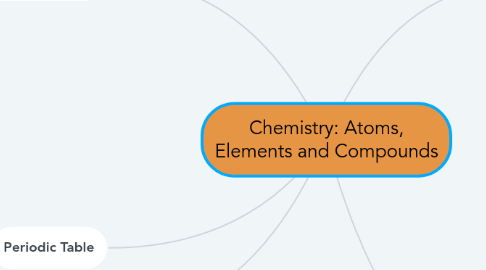Chemistry: Atoms, Elements and Compounds
создатель Mdsn Mrtnz


1. Ionic Compounds
1.1. Properties: - Have high melting points - Form crystals, which are very regular arrangements of particles - Dissolve in water
1.2. Formulas (ex.) : Aluminum Sulfide & Boron Phosphide Al3+ S2- B P3- Al3+ Al3+ B S2- S2- S2- P3- Formula: A2S3 BP
2. Periodic Table
2.1. Atomic number: The number of protons in an atom of an element.
2.2. Atomic mass: Average mass of an element's atom.
3. Laws of Attraction
3.1. Laws: - Particles with opposite charges attract each other - Particles with like charges repel each other
4. Atomic theory
4.1. Nature of Matter: - All matter is made up of small invisible particles called atoms. - All the atoms of an element are identical in properties; size & mass. - Atoms of different elements have different properties. - Atoms of different elements can combine to form new substances.
4.2. J.J. Thomson's Discovery: Bc he had detected negatively charged particles, he reasoned that atoms, which have no over all charge, must also contain positive charges.
4.3. Ernest Rutherford's Discovery: The nucleus is located in the centre of the atom. This tiny positively charged part of the atom also contains most of the atom's mass. So, it is a positive charge.
4.4. James Chadwick's Discovery: The nucleus contains neutral particles (neutrons) as well as positive particles (protons). Each neutron is the same mass as each proton in the same atom, but carries no electrical charge.
4.5. Neils Bohr's Discovery: Electrons are arranged by hydrogen & magnesium. Electrons surround the nucleus in energy levels; shells. Electrons jump between these shells by gaining/losing energy. Each shell can contain a specific number of electrons.
5. Elements
5.1. Element Classes
5.1.1. Alloy: A mixture of two or more metals.
5.1.2. Metal properties: excellent conductors of electricity & heat, malleable & ductile, moulded & shaped easily. ex. silver, sodium, platinum, mercury
5.1.3. Non-Metal properties: do not resemble metals. ex. gases, solids, bromine, sulphur
5.1.4. Metalloids: elements w/ metallic & non-metallic properties, conducts energy but not well; semiconductors. ex. sillicon

